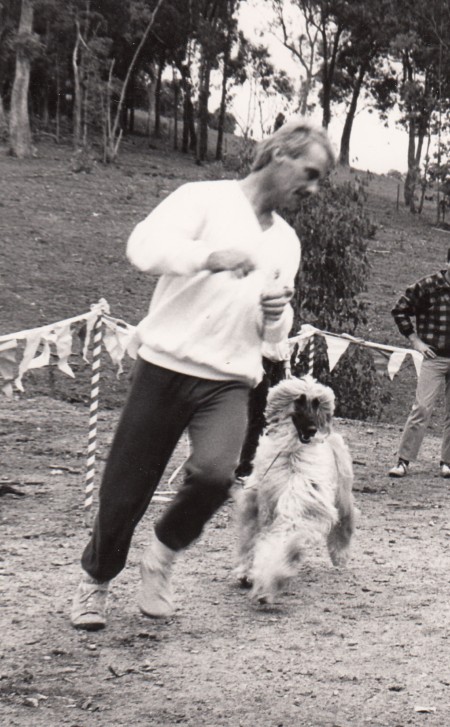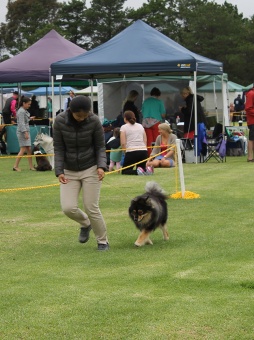
Stand straight, run upright. What ever you do don’t bend down or beg
Here’s a question for you. Based on the following two examples, which handler is exhibiting the body language of a ‘TOP DOG’?
 Example A:
Example A:
- After their individual judging inspection, the handler leaves the judge bent over with their right hand out in front of their dog coaxing (or baiting) it with food and/or voice signals.
- The handler maintains this posture throughout their out and back run.
- Upon returning to the judge, the handler remains bent over, all the while teasing their dog with food and/or making a series of persistent ‘clucking’ noises to gain their dog’s attention.
 Example B:
Example B:
- After their individual judging inspection, the handler stands straight and tall with their shoulders back and head held high.
- Before moving off for their out and back run, the handler gives their dog a positive action sound.
- Once they have gained their dog’s attention, they move off, all the while maintaining an upright posture.
- Upon returning to the judge, the handler provides their dog with a clear calming signal while the dog stands still, looking attentively to their handler for their next signal.
If you answered B, then you’re absolutely correct. Dogs have an uncanny sense to identify the TOP DOG in a matter of seconds. And, as is a dog’s nature, they are hard-wired to follow the leader.
If you’re not convinced, try this. Next time your dog ‘meets’ a new dog (whether on or off the lead), watch how they approach one another. Within seconds, one dog will elevate its posture, while the other dog ‘submits’. Submissive behaviour can include anything from lowering the head or forequarter to even rolling over on the back.

It is part of nature’s unwritten law that the dog demonstrating more assertive behaviour will not usually attack the dog showing more submissive behaviour. This is why you might observe two dogs walking around each other, sniffing one another, playing or simply losing interest and walking off. Rarely will you see them fight.
Fast forward to the show ring. When a handler lowers their physical stature to coax or encourage their dog (because they ‘think’ that the dog is nervous, frightened or unhappy), the dog instinctively interprets this behaviour as submissiveness. Hence, without consciously meaning to, the handler has transferred their leadership position to their dog.
When this happens, you can observe how the dog will now revert to doing ‘dog things’ (e.g. sniffing, pulling, chasing etc.). They are no longer paying respectful attention to the handler, which means the only remaining control left to the handler is that of the lead (i.e. force).
From most dog owner’s point of view, this type of conciliatory behaviour is not intended as one of weakness but that of sympathy and compassion.
For example, if I were to interact with an upset or unsettled human child, I would not stand tall with my shoulders back, head held high, arms folded and stare down at the child while commanding them to do something. What I would do is to lower my height (as not to look so imposing), soften my voice and, in a low, calm and soothing voice, ask them what is wrong.
We take this approach to comfort children and to reduce or eliminate whatever fear or discomfort they are feeling. However, when it comes to handling dogs, we have to realise that we’re dealing with a dog and not a child – and they are not the same thing.
Dogs interpret our body language in ‘dog’ terms. They do not logic through human behaviours and responses. They interpret our requirements and actions in dog ‘language’, which is why it’s so important that we communicate with our canine friends in ways that make sense to them.
While we can rarely identify ‘dog’ signals as quickly or as accurately at other dogs do, we can learn to understand their body language and simulate our own in ways close enough for our dogs to comprehend.
This is why I say that whether you’re training or showing a dog, you should stand up straight with you shoulders back and head held high, be positive and always act like the leader. If you do this, your dog won’t be guessing who’s who in the ‘natural’ order and will be much more likely to do, as you want, when you want.
The TOP DOG never begs another dog. So, if you want to be leader in your ‘pack’, make sure your body language says so.

GREAT article.. after years of showing and judging dogs I know you are correct and I still make that mistake and notice with other too. sharing thanks again
Hey I show dogs too, we are all human and it is very hard to to be in conflict with our natural instincts, but dogs interpret our signals as dogs not as humans and therefore we have to fight the urge to be human when working with dogs.Very much appreciate you input.Best Peter.
Thanks for this! As a relative newcomer to handling, this is great to know!
Glad this is of help. Best of luck with you showing. Peter.